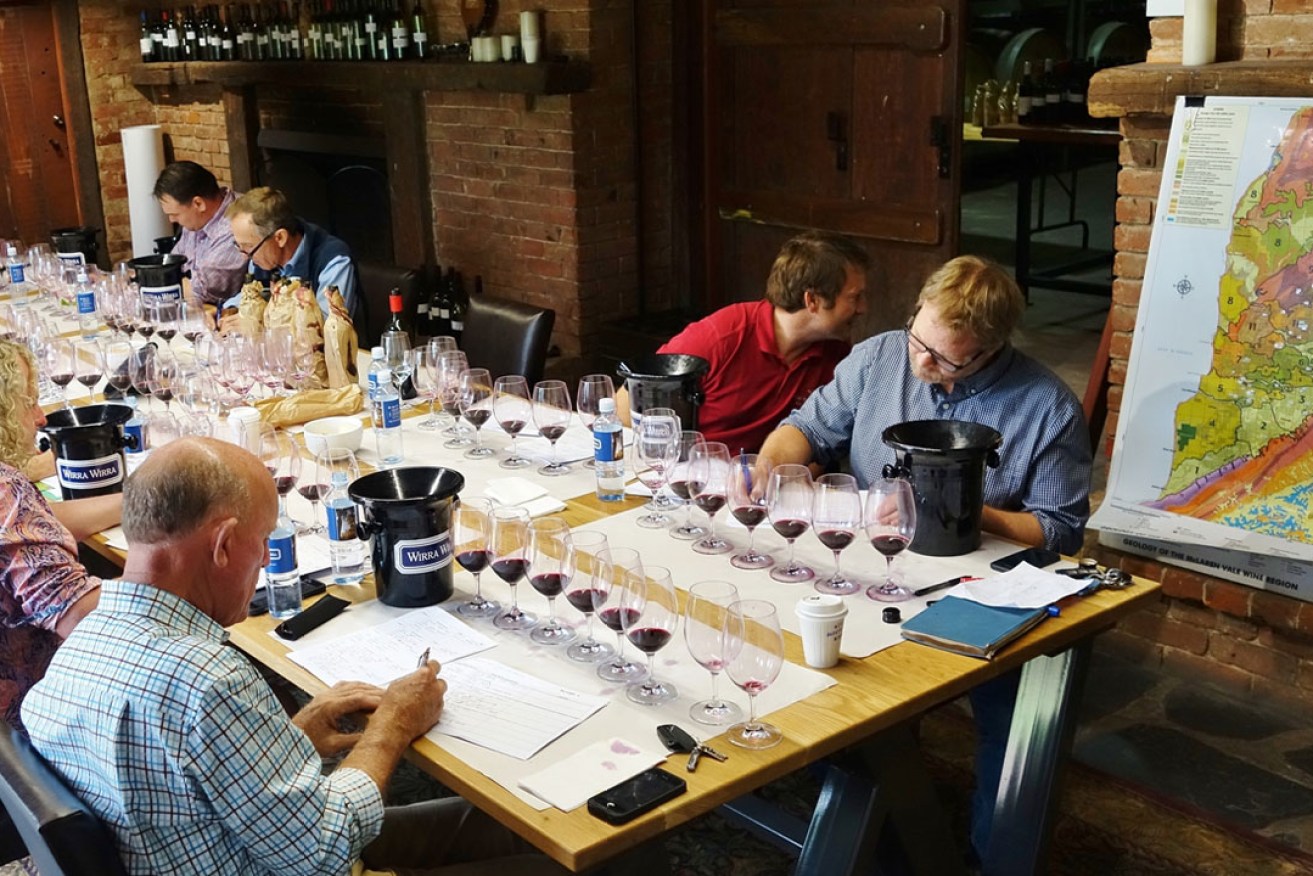Licking rocks again
Whitey’s been chewing over the 2017 McLaren Vale Districts tasting.


Tasting the McLaren Vale Districts at Wirra Wirra. Photo: Philip White
While its maceration still confounds me as it growls around my mind, the McLaren Vale Districts Tasting 2017 left a few prominent, and I reckon fairly trustworthy, presumptions.
That’s probably presumptuous. Let’s forget that. We’ll call ’em suspicions worth pursuit.
This annual event is where a group of bright McLaren Vale winemakers sit around examining flights of Shiraz deliberately made according to their source terroirs, stored in neutral aged oak for a year, decanted into a bottle and presented.
This is a full-bore forensic tasting conducted by local experts fluent in the most complex aspects of their region’s unique terroir and history. I had a couple of years away from the table and it was a delight to be back there in that fruity-yet-crisp intellectual and organoleptic atmosphere. The table bristles like a chess championship, or a Miles Davis rehearsal.
Everyone gets their solo.
The trick is not to go fault-hunting. The appraisal nerves here are most useful wrapped entirely around the matter of whether or not the wines in each subgroup share component factors. If they do, what are they? If they don’t, why not? What else do they offer?
The individual shards of memory and notes of this tasting won’t be of much use scientifically until they’re added to the database built from all these vintages of annual appraisals and countless hours of discussion through each year.
Wes Pearson, who slides comfortably down the razor blade between the Dodgy Brothers, his winemaking partnership, and his other life as a scientist at the Wine Research Institute, ran the tasting in a methodical and reassuring way. In an operation which can suddenly seem overwhelmingly complex, it’s good to feel reassured as you progress.
First, all the wines were brought in by makers who pinpointed their source on the Geology of the McLaren Vale Wine Region* map of 2010. A committee, including some of these expert tasters, has been working to establish a series of sub-regional compartments based on geology and often a more complex discussion of aspect and climate and other critical influences on the tricky bits.
They call these sub-regions Districts. They are not recognised in any law, but are tentative sub-regional boundaries for agricultural, geological, organoleptic, œnological and viticultural study. It’s about science, not marketing. It’s nascent science.
First up, while the 60-odd entries were poured in 11 flights, we first tasted blends of all the wines from each district. These we discussed intensely. Equal proportions of each entrant from a particular district would be blended and poured, then pored over.
Next, district by district, we examined the individual components, always then reflecting on the vineyard’s geology and site. Sometimes there were only three or four wines, so one treads with great sensitivity. Other districts had many more entries.
There are a couple of possible trends that fascinate me most this early in the piece.
First, I felt the 2016 vintage may have been outstanding for the way in which the year and its conditions overwhelmed many abiding suspicions and presumptions I’d had about geology. The boundaries were a little smudged this year. Like overall, these were elegant, racy wines without so much of the fat the local runners can put on so easily.
I certainly had my favourites, but to me, the lithe style of the year seemed to overwhelm a lot of the geological hints I’d expected.
Otherwise, there could be a shot of subconscious industrial psychological stuff going here where the winemakers quietly and probably independently decide to show a bit more attention to letting their grounds speak by pursuing a more elegant style for the barrel they set aside for this remarkable exercise.
You get a fashion drift like that now and then.
If in this instance, the vintage has magnified their focus, making the goal closer and more easily attained; that’s very cool.
If it’s only a viticultural fashion or accounting thing, I hope there’s some science to it.
To my burnished saxophone, one geological base totally distinctive was the calcareous Eocene (young at 56-34 million years) geology of the Blanche Point formation, which reappears in various locations spread kilometres apart. These old seabeds almost invariably dinged up a tab of descriptors more akin to a ripe and juicy young Coonawarra. In this case, geology seems to overwhelm vintage.
Please don’t begin to think these reflections of mine will suddenly change your eventual bottle of McLaren Vale: this was merely 60 trial barrels out of the region’s 3218 hectares of Shiraz. There will be many more woody, and probably many a bit like this eventually assembled from each cellar’s stack. But there’s plenty of time left for polishing. The blenders have not touched these wines.
Which is what makes them special.
Neither does this tasting have anything to do with the so-called Scarce Earths Shiraz marketing scheme, which obviously causes great confusion to those being introduced to this project.
Consider the unpronounceable Scarce Earths, which in China translates to Rare Earths, which are a set of glowing beauties on the Periodic Table. They’re used in stuff like warheads and phone batteries and China’s probably got most of it waiting to be mined. See how easy I get off the track … I set out to say the committees of good folk who’ve spent years on these studies could help individual local growers confirm their geology so they could sell that vineyard’s wine under the region’s special seal to guarantee that geology, whatever the variety. There’d be a more inclusive and varied stable presented from across the vignoble: one which includes all the new varieties being planted by pioneers and adventurers who deserve as much recognition as the old couch potaters.
*Geology of the McLaren Vale Wine Region, PIRSA Minerals and Energy Resources South Australia Publishing Services, Government of South Australia June 2010.
drinkster.blogspot.com




